

Red Worm Composting. Physical Variation During Predigestion of Selected Organic Waste Before Vermicomposting. 1: Bajsa, O., J.
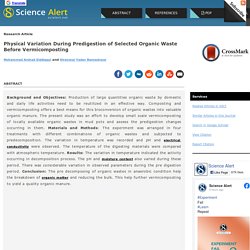
Nair, K. Mathew and G.E. Ho, 2003. Cookie Consent and Choices. The Basics of Vermicomposting. Published Feb. 2017|Id: BAE-1528 By Douglas W.
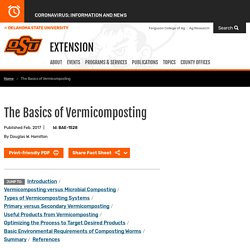
Hamilton Introduction This Fact Sheet is for people interested in making compost with worms – whether they intend to do it under the kitchen sink or on a two-acre worm farm. Vermiculture (raising earthworms) and Vermicomposting (making compost with worms) have their own special vocabulary. Vermicomposting.html?payload=<request xmlns=" Composting with the help of worms is a practice known as vermicomposting and is a useful spin on the typical methods of composting.
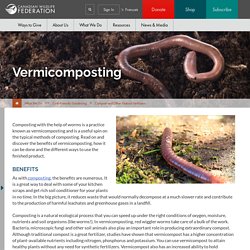
Read on and discover the benefits of vermicomposting, how it can be done and the different ways to use the finished product. Benefits As with composting, the benefits are numerous. It is a great way to deal with some of your kitchen scraps and get rich soil conditioner for your plants in no time. In the big picture, it reduces waste that would normally decompose at a much slower rate and contribute to the production of harmful leachates and greenhouse gases in a landfill. Vermicomposting: An Effective Option for Recycling Organic Wastes. Abstract Urbanization and industrialization resulted in rapid increase in volume of solid waste; its management has become one of the biggest problems today.

Solid wastes can be disposed off by methods like land filling, incineration, conversion into biogas, recycling, and composting, but its overproduction has led to inappropriate disposal practices such as their indiscriminate and inappropriately timed application to agricultural fields that ultimately leads to water and soil pollution. However, if handled properly, these organic wastes can be used for vermicomposting; it is an effective recycling technology that improves the quality of the products which is disinfected, detoxified, and highly nutritive.
It is a low cost, eco-biotechnological process of waste management in which earthworms are used to cooperate with microorganisms in order to convert biodegradable wastes into organic fertilizer. How to Create and Maintain an Indoor Worm Composting Bin. A worm composting bin, known as a vermicomposter, can be fairly inexpensive and easy to maintain.
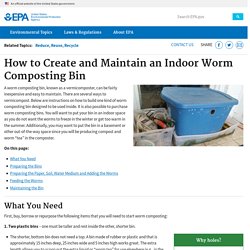
There are several ways to vermicompost. Below are instructions on how to build one kind of worm composting bin designed to be used inside. The Complete Guide to Worm Farming, Vermicomposting Made Easy – Deep Green Permaculture. Worm Farms are a great way to recycle kitchen waste and food scraps into one of the best garden fertilizers available!
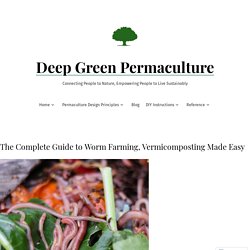
It’s very easy to maintain a worm farm, it takes very little time and effort, and you can set up worm farms in the smallest of spaces, such as balconies and courtyards. Worms farms are in fact worm composting systems, or more correctly, vermicomposting systems, and earthworms are one of the fastest composters there are. In this article we’ll discuss how worm farms work, how to set up a worm farm and how to take care of it. Choosing a Worm Farm You can buy or build a worm farm, and they come in all shapes and sizes to suit all tastes and requirements.
The Adventures of Herman the Worm. Bacteria and earthworms - microbewiki. Introduction Earthworms are essential components of the terrestrial soil ecosystem.

Picture taken in Swifts Creek, Victoria in June 2007, courtesy of the Wikimedia Commons. Worm farms. Compost * worm castings. Vermicompost, the story of organic gold: A review. Agricultural Sciences Vol.3 No.7(2012), Article ID:24396,13 pages DOI:10.4236/as.2012.37110 Vermicompost, the story of organic gold: A review Sujit Adhikary Agriculture & Ecological Research Unit, Biological Sciences Division, Indian Statistical Institute, Kolkata, India; sujit@isical.ac.in, drsujitadhikary@yahoo.com.
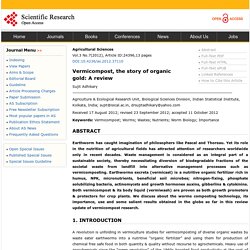
Instrumental characterization of organic wastes for evaluation of vermicompost maturity. Introduction Vermicomposting is a biological process used to convert complex organic wastes into a stabilized nutrient-rich fertilizer called vermicompost.
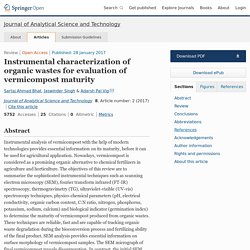
Vermicomposts are peat-like materials containing plant growth hormones and nutrients in plant available forms (Lim et al. 2016). In vermicomposting process, earthworms and microbes of their gut degrades organic waste and forms a stable and mature product (Bhat et al. 2013; Lim et al. 2016). Organic waste recycling and its use as a soil conditioner is the attractive method for waste management. The application of organic manures produced from organic wastes by vermicomposting is one of the ways to maintain soil fertility and reduce the soil pollution (Ostos et al. 2008; Bhat et al. 2016a). Vermicompost humic acid: Topics by Science.gov. Chlorpyrifos-methyl solubilisation by humic acids used as bio-surfactants extracted from lignocelluloses and kitchen wastes.
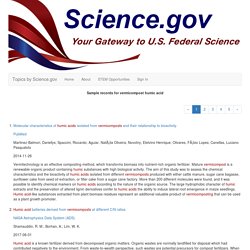
PubMed Scaglia, Barbara; Baglieri, Andrea; Tambone, Fulvia; Gennari, Mara; Adani, Fabrizio 2016-09-01 Chlorpyrifos-methyl (CLP-m) is a widely used organophosphate insecticide that can accumulate in soil and become toxic to humans. CLP-m can be removed from soil by its solubilisation using synthetic surfactants. However, synthetic surfactants can accumulate in soil causing contamination phenomena themselves. Bio-surfactants can be used as an alternative to synthetic ones, reducing costs and environmental issues. In this work, humic acid (HA) extracted from raw biomasses, i.e. lignocelluloses (HAL) and lignocelluloses plus kitchen food waste (HALF), corresponding composts (C) (HALC and HALFC) and leonardite (HAc), were tested in comparison with commercial surfactants, i.e.
Vermiculture pdfs.